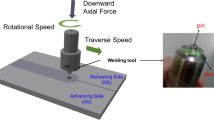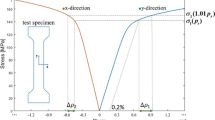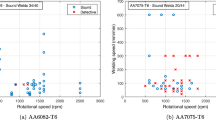Abstract
In this paper, using the ultrasonic method, the residual stress due to friction stir welding of two different metals aluminum 5754 and copper is investigated. Furthermore, the effects of changing the rotational speed and speed of movement along the welding path on residual stress are presented. For this purpose, some experimental tests are considered. The results show that the residual stress in the pin area is higher than stress in other zones of the weld which is due to the pressure applied by the pin to the parts. Furthermore, based on the presented results, decreasing the speed of movement along the welding path and increasing the rotational speed increase the residual stress in sheets. The results also indicate that the residual stress in aluminum is greater than the residual stress in the copper sheet since the thermal conductivity of the aluminum is smaller and the stiffness of the aluminum is greater than those corresponding to copper. The results show that the ultrasonic method can be used to specify the residual stress in friction stir welding of two different materials. To ensure the quality of the welding, the optical microscopy image of a cross-section from the HAZ zone is presented.

















Similar content being viewed by others
Data availability
All data generated or analyzed during this study are included in this published article.
Change history
17 September 2021
Springer Nature’s version of this paper was updated to present the correct author affiliations.
References
Taban E, Gould JE, Lippold JC (2010) Dissimilar friction welding of 6061-T6 aluminum and AISI 1018 steel: properties and microstructural characterization. Mater Des 31(5):2305–2311
Li J, Yang JG, Li HL, Yan DJ, Fang HY (2009) Numerical simulation on bucking distortion of aluminum alloy thin-plate weldment. Front Mater Sci China 3(1):84–88
Alinaghian I, Honarpisheh M, Amini S (2018) The influence of bending mode ultrasonic-assisted friction stir welding of Al-6061-T6 alloy on residual stress, welding force and macrostructure. Int J Adv Manuf Technol 95(5):2757–2766
Assidi M, Fourment L, Guerdoux S, Nelson T (2010) Friction model for friction stir welding process simulation: calibrations from welding experiments. Int J Mach Tools Manuf 50:143–155
Astarita A, Coppola M, Esposito S, Liberini M, Maio L, Papa I, Scherillo F, Squillace A (2016) Experimental characterization of Ti6Al4V T joints welded through linear friction welding technique: microstructure and NDE. Adv Manuf 4(4):305–313
Dialami N, Chiumenti M, Cervera M, Segatori A, Osikowicz W (2017) Enhanced friction model for Friction Stir Welding (FSW) analysis: simulation and experimental validation. Int J Mech Sci 133:555–567
Vairis A, Papazafeiropoulos G, Tsainis A-M (2016) A comparison between friction stir welding, linear friction welding and rotary friction welding. Adv Manuf 4(4):296–304
Shokri V, Sadeghi S, Sadeghi MH, Javadi Y (2015) Effect of heat input ratio on residual stress in multipass welding using finite element method and ultrasonic stress measurement. J Nondestruct Eval 34(3):27
Ghate ND, Sood A, Srivastava A, Shrivastava A (2020) Ductile fracture based joint formation mechanism during friction stir welding. Int J Mech Sci 168:105293
Hamilton C, Dymek S, Sommers A (2008) A thermal model of friction stir welding in aluminum alloys. Int J Mach Tools Manuf 48(10):1120–1130
Raja AR, Vashista M, Khan Yusufzai MZ (2020) Estimation of material properties using hysteresis loop analysis in friction stir welded steel plate. J Alloys Compd 814:152265
Sun T, Roy MJ, Strong D, Simpson C, Withers PJ, Prangnell PB (2019) Weld zone and residual stress development in AA7050 stationary shoulder friction stir T-joint weld. J Mater Process Technol 263:256–265
Naik BS, Cao X, Wanjara P, Friedman J, Chen D (2015) Residual stresses and tensile properties of friction stir welded AZ31B-H24 magnesium alloy in lap configuration. Metall Mater Trans B 46(4):1626–1637
Gachi S, Fouad B, Belahcene F (2011) Residual stress, microstructure and microhardness measurements in AA7075-T6 FSW welded sheets. Nondestruct Test Evaluation 26:1–11
Jafari H, Mansouri H, Honarpisheh M (2019) Investigation of residual stress distribution of dissimilar Al-7075-T6 and Al-6061-T6 in the friction stir welding process strengthened with SiO2 nanoparticles. J Manuf Process 43:145–153
Saeid T, Abdollah-zadeh A, Sazgari B (2010) Weldability and mechanical properties of dissimilar aluminum–copper lap joints made by friction stir welding. J Alloys Compd 490(1):652–655
Gachi S, Belahcene F, Boubenider F (2009) Residual stresses in AA7108 aluminium alloy sheets joined by friction stir welding. Nondestruct Test Evaluation 24(3):301–309
Farrokhi H, Heidarzadeh A, Saeid T (2013) Frictions stir welding of copper under different welding parameters and media. Sci Technol Weld Join 18(8):697–702
Hou Z et al (2018) Residual stresses in dissimilar friction stir welding of AA2024 and AZ31: experimental and numerical study. J Manuf Sci Eng 140(5):051015 (10 pages)
Crecraft DI (1967) The measurement of applied and residual stresses in metals using ultrasonic waves. J Sound Vib 5(1):173–192
Mohammadi M, Fesharaki JJ (2019) Determination of acoustoelastic/acoustoplastic constants to measure stress in elastic/plastic limits by using LCR wave. NDT&E Int 104:69–76
Sadeghi S et al (2013) Using ultrasonic waves and finite element method to evaluate through-thickness residual stresses distribution in the friction stir welding of aluminum plates. Mater Des (1980-2015) 52:870–880
Javadi Y, Akhlaghi M, Najafabadi MA (2013) Using finite element and ultrasonic method to evaluate welding longitudinal residual stress through the thickness in austenitic stainless steel plates. Mater Des 45:628–642
Zhao W, Wu C (2019) Constitutive equation including acoustic stress work and plastic strain for modeling ultrasonic vibration assisted friction stir welding process. Int J Mach Tool Manu 145:103434
Tarraf J, Mustapha S, Fakih MA, Harb M, Wang H, Ayoub G, Hamade R (2018) Application of ultrasonic waves towards the inspection of similar and dissimilar friction stir welded joints. J Mater Process Technol 255:570–583
Meng X, Jin Y, Ji S, Yan D (2018) Improving friction stir weldability of Al/Mg alloys via ultrasonically diminishing pin adhesion. J Mater Sci Technol 34:1817–1822
Javadi Y, Hasani M, Sadeghi S (2015) Investigation of clamping effect on the welding sub-surface residual stress and deformation by using the ultrasonic stress measurement and finite element method. J Nondestruct Eval 34(1):3
Sagar SP, Miyasaka C, Ghosh M, Tittmann BR (2012) NDE of friction stir welds of Al alloys using high-frequency acoustic microscopy. Nondestruct Test Evaluation 27(4):375–389
Javadi Y, Sadeghi S, Najafabadi MA (2014) Taguchi optimization and ultrasonic measurement of residual stresses in the friction stir welding. Mater Des 55:27–34
Javadi Y, Akhlaghi M, Najafabadi MA (2014) Nondestructive evaluation of welding residual stresses in austenitic stainless steel plates. Res Nondestruct Eval 25(1):30–43
Hughes DS, Kelly JL (1953) Second-order elastic deformation of solids. Phys Rev 92(5):1145–1149
Montazerolghaem H, Fadaie Tehrani A, Badrossamay M (2014) An innovative approach for manufacturing of thin welded blanks and coils. Mater Manuf Process 29(8):889–893
Bray DE, Junghans P (1995) Application of the LCR ultrasonic technique for evaluation of post-weld heat treatment in steel plates. NDT&E Int 28(4):235–242
Author information
Authors and Affiliations
Contributions
All authors developed the theory and performed the computations. Also, all authors discussed the results and contributed to the final manuscript.
Corresponding author
Ethics declarations
Ethics approval
For this type of study, formal consent is not required.
Consent to participate
The authors voluntarily agreed to participate in this research study.
Consent for publication
The author transfers to Springer the non-exclusive publication rights and he warrants that his/her contribution is original and that he/she has full power to make this grant. The author signs for and accepts responsibility for releasing this material on behalf of all co-authors. This transfer of publication rights covers the non-exclusive right to reproduce and distribute the article, including reprints, translations, photographic reproductions, microform, electronic form (offline, online), or any other reproductions of similar nature. The author may self-archive an author-created version of his article on his own website and his institution’s repository, including his final version; however he may not use Springer’s PDF version which is posted on www.springerlink.com. Furthermore, the author may only post his version provided acknowledgment is given to the Journal and Springer as one of the original places of publication and a link is inserted to the published article on Springer’s website.
Competing interests
The authors declare no competing interests.
Additional information
Publisher’s note
Springer Nature remains neutral with regard to jurisdictional claims in published maps and institutional affiliations.
Rights and permissions
About this article
Cite this article
Valizadeh, A., Montazerolghaem, H. & Fesharaki, J.J. Detection of residual stress in friction stir welding of heterogeneous aluminum/copper sheets—ultrasonic method. Int J Adv Manuf Technol 117, 97–108 (2021). https://doi.org/10.1007/s00170-021-07746-4
Received:
Accepted:
Published:
Issue Date:
DOI: https://doi.org/10.1007/s00170-021-07746-4




